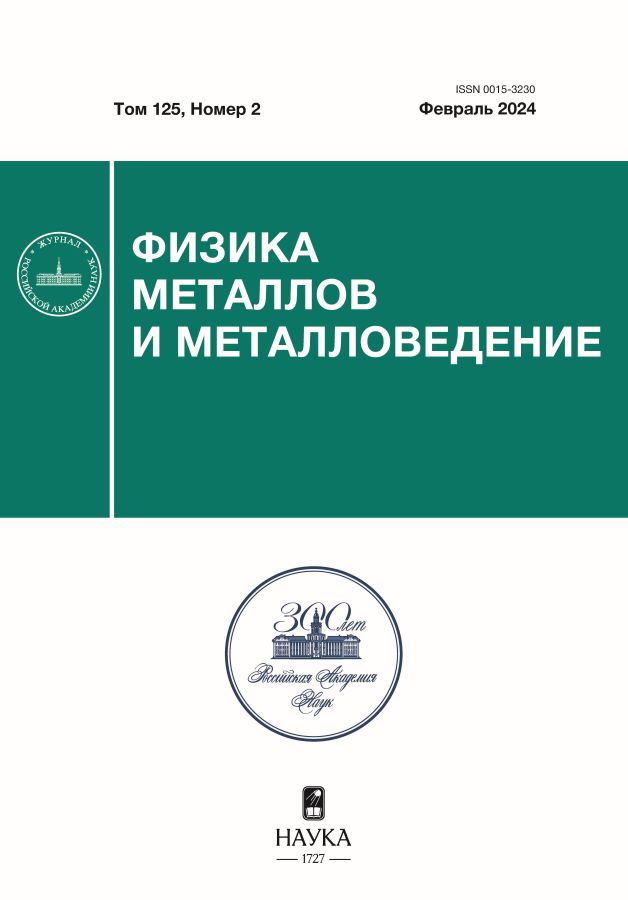Relaxation of the Excess Free Volume of the Phase Transformation at the Interphase Boundary between the Crystal and the Melt
- Authors: Esin V.O.1
-
Affiliations:
- Mikheev Institute of Metal Physics, Ural Branch, Russian Academy of Sciences
- Issue: Vol 125, No 2 (2024)
- Pages: 191-194
- Section: СТРУКТУРА, ФАЗОВЫЕ ПРЕВРАЩЕНИЯ И ДИФФУЗИЯ
- URL: https://rjmseer.com/0015-3230/article/view/662819
- DOI: https://doi.org/10.31857/S0015323024020096
- EDN: https://elibrary.ru/YOVZOO
- ID: 662819
Cite item
Abstract
The mechanism of relaxation of the excess free volume of phase transformation released in the region of local dilation at the interphase boundary (MFG) of a crystal with a melt is considered. The analysis of the structural state of the MFG and its effect on the mobility of the boundary under the conditions of pressure application during the growth of the crystal from the melt is carried out. An explanation is given of the extreme influence of pressure on the mobility of the MFG and the possibility of the state of abnormally high mobility of the boundary under conditions of the application of “optimal” pressure in magnitude (“super-mobility” of the MFG). Within the framework of the mechanism of viscous melt flow into the region of local dilation at the MFG, which occurs during crystallization, a quantitative agreement was obtained with the experimental value of the “optimal” pressure in terms of magnitude, which determines the extreme nature of the mobility of the crystal boundary with the melt.
Full Text
About the authors
V. O. Esin
Mikheev Institute of Metal Physics, Ural Branch, Russian Academy of Sciences
Author for correspondence.
Email: yesin@imp.uran.ru
Russian Federation, Ekaterinburg, 620108
References
- Френкель Я.И. Вязкое течение в кристаллических телах // ЖЭТФ. 1946. Т. 16. № 1. С. 29–38.
- Есин В.О., Кривоносова А.С., Саттыбаев И.Ж., Федорова Т.Г., Елохина Л.В. Влияние давления и гравитационного поля на распределение Cu при направленном росте монокристалла сплава Al-0.005 вес% Cu // ФММ. 2023. Т. 124. № 12. С. 1230–1236.
- Есин В.О. Сверхподвижность межфазной границы кристалл – расплав / VII Научная конференция по росту кристаллов. (14–19 ноября 1988, Москва). Т. III. Рост кристаллов из расплава. Расширенные тезисы. М.: АН СССР, 1988. С. 43–44.
- Есин В.О., Кривоносова А.С., Саттыбаев И.Ж., Федорова Т.Г., Елохина Л.В. Влияние давления на структуру монокристаллов алюминия и седиментацию растворенных компонентов при кристаллизации во внешнем потенциальном поле // ФММ. 2005. Т. 100. № 2. С. 63–69.
- Frenkel Y.I. The Liquid State and the Theory of Fusion // Acta Phys. URSS. 1935. № 3. P. 633–648.
- Herring C. Diffusional viscosity of a polycrystalline solid // J. Appl. Phys. 1950. V. 21. P. 437–445.
- Лифшиц И.М. К теории диффузионно-вязкого течения поликристаллических тел // ЖЭТФ. 1963. Т. 44. № 4. С. 1349–1367.
- Coble R.L. A model for boundary – diffusion controlled creep in polycrystalline materials // J. Appl. Phys. 1963. V.34. P. 1679–1682.
- Nabarro F.R.N. Steady state diffusional creep // Philos. Mag. 1967. V. 16. P. 231–237.
- Бокштейн Б.С., Бокштейн С.З., Жуховицкий А.А. Термодинамика и кинетика диффузии в твердых телах. М.: Металлургия, 1974. 280 с.
- Есин В.О. Кластерная структура металлических расплавов / В кн.: Структура и физико-химические свойства металлических и оксидных расплавов. Свердловск: УНЦ АН СССР, 1986. С. 57–67.
- Есин В.О., Кривоносова А.С., Карпов Г.Н., Хигер Б.С. Влияние избыточного давления газовой среды при кристаллизации на субструктуру монокристаллов алюминия // ФММ. 1974. Т. 38. Вып. 4. С. 870–873.
- Задумкин С.Н., Хоконов Х.Б., Шокаров Х.Б. Акустический эффект кристаллизации и плавления вещества // ЖЭТФ. 1975. Т. 68. Вып. 4. С. 1315–1320.
- Жекамухов М.Х., Шокаров Х.Б. О природе высокочастотных акустических волн, возникающих при кристаллизации и плавлении веществ / ai21_AE_2000. www2.fep.tsure.ru/books/conferenc/pem2000/pape1/ai21.pdf.
- Vorontsov V.B. and Katalnikov V.V. Analysis of acoustic emission effect accompanying metal сrystallization / 13th International Conference on Liquid and Amorphous Metals // J. Phys.: Conference Series. 2008. V. 8. Р. 052005.
- Воронцов В.Б., Журавлев Д.В. Связь структуры сигналов акустической эмиссии при кристаллизации Al с механизмом формирования твердой фазы из расплава // Вестник Новг. ГУ. 2012. № 67. С. 8–13.
- Vorontsov V.B., Pershin V.K. Experimental research of phase transitions in a melt high – purity aluminum // Journal of Crystal Growth. 2017. V. 480. P. 170–174.
Supplementary files










